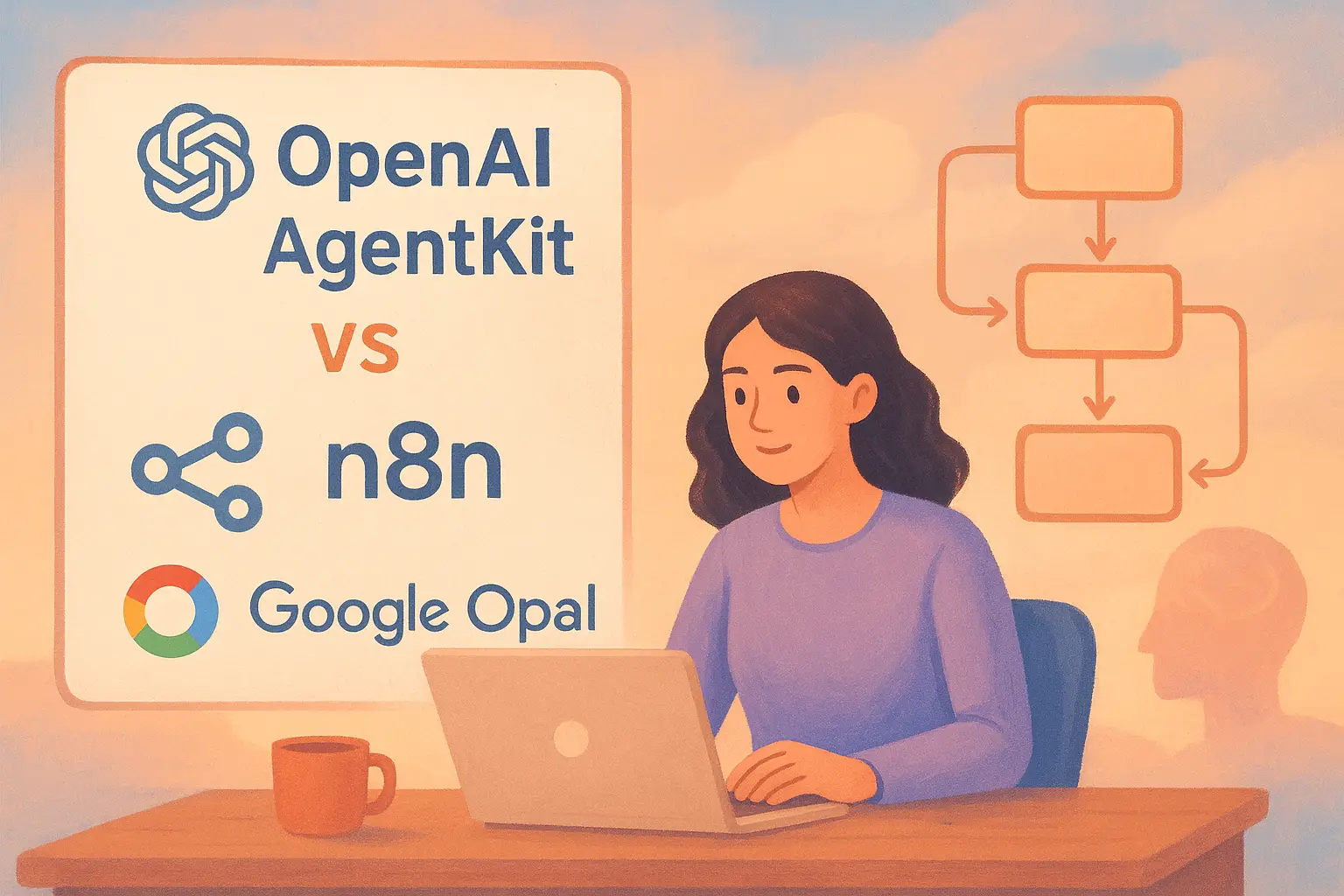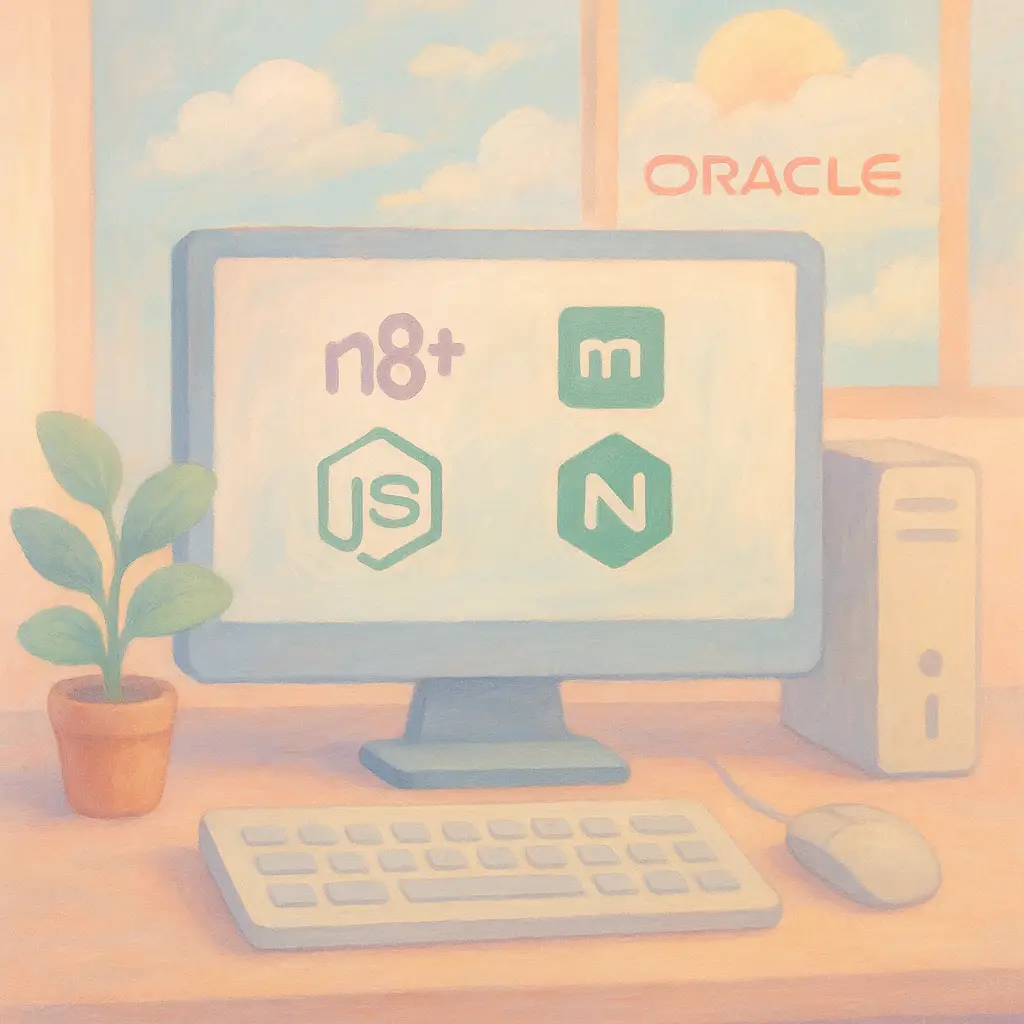
AgentKit vs n8n vs Opal: AI Tools 2025
Table of Contents
- Introduction
- Why OpenAI AgentKit is a Game Changer
- Understanding OpenAI AgentKit
- Comparing AgentKit with n8n
- Contrasting AgentKit with Google Opal
- Practical Implementations and Use Cases
- Technical Underpinnings
- Pricing, Availability, and Future Outlook
- Conclusion
- Frequently Asked Questions (FAQs)
Introduction
In recent years, the world of AI automation has surged forward with rapid innovation and transformative tools that empower both developers and enterprises. One such breakthrough is OpenAI AgentKit, a comprehensive framework built to streamline the entire lifecycle of creating intelligent agents. In this 2025 guide, we will explore how AgentKit stands head and shoulders above its main competitors, namely n8n and Google Opal.
This article dives deep into the origins, architecture, and practical applications of AgentKit, comparing its capabilities against N8N's open-source versatility and Google Opal's no-code solutions. By the end, you will have a well-rounded understanding of why OpenAI AgentKit is a game changer for AI automation and how it paves the way for more adaptive and highly efficient agentic workflows.
Why OpenAI AgentKit is a Game Changer
When you look at AI automation tools, the details often matter as much as the big picture. AgentKit is more than just another box to tick; it is a unified platform that simplifies the building, deployment, and optimization of software agents. Imagine cutting down days or even weeks of development time into a matter of hours. That is the promise of AgentKit.
AgentKit works by unifying several complex functionalities into a clean, visual framework. Rather than juggling between disparate tools for orchestration, UI design, and evaluation, developers now have a single dashboard that handles it all. This unified approach not only minimizes error but also speeds up the prototyping and deployment stages considerably.
One of the key benefits of AgentKit is its inherent scalability. Whether you're a startup testing the waters or an enterprise managing multi-agent workflows, AgentKit adapts seamlessly to your needs. It offers fine-grained control over every aspect of agent behavior, from prompt logic to external integrations.
Moreover, AgentKit's built-in governance and audit logs ensure that crucial decision points are transparent, which is critical for sectors like finance, healthcare, and legal. With data security and compliance at the forefront, enterprises can leverage AgentKit without worrying about regulatory setbacks.
Understanding OpenAI AgentKit
AgentKit is OpenAI's flagship solution for building intelligent agents. It moves away from the traditional SDK approach and embraces a visual, drag-and-drop paradigm that caters to both technical and non-technical users alike.
Key Components of AgentKit
-
Visual Agent Builder: A dynamic canvas empowers users to architect agent workflows using intuitive nodes. With a simple drag-and-drop interface, you can sketch out even the most complex inter-agent handoffs and decision trees.
-
Connector Registry: This component acts as a central hub for integrating with external services such as file storage, third-party APIs, and databases. The registry ensures that every connection is governed and audited, thus preserving security and compliance.
-
ChatKit: At the forefront of user interaction, ChatKit allows for the creation of chat-driven interfaces that merge conversational AI with practical agent actions. This ensures that end-users have a seamless, interactive experience.
-
Evaluation Pipeline (Evals): Imagine having a built-in system that not only grades but also provides step-by-step traces of how an agent arrived at its conclusion. The evaluation pipeline does exactly that and even supports live prompt optimization.
-
Reinforcement Fine-Tuning (RFT): AgentKit supports dynamic adjustment through reinforcement learning. Fine-tuning agent behavior based on real-time feedback is what gives your AI applications that extra edge in performance.
-
Guardrails, Versioning, and Audit Logs: Every step of your agent's journey is logged and versioned. Whether to prevent data leaks or monitor compliance, these features provide a level of transparency that is indispensable in a regulated environment.
The philosophy behind AgentKit is to democratize agentic AI application development. Instead of being a playground for only tech giants or specialized developers, AgentKit levels the playing field so that anyone with a vision for AI automation can dive in and create meaningful, robust agents.
Comparing AgentKit with n8n
When evaluating AI automation platforms, one of the first names that come up is n8n. As an open-source alternative that has been embraced by many developers, n8n has made its mark in the automation community. However, when it comes to advanced multi-agent workflows, AgentKit clearly has the upper hand.
Strengths of n8n
n8n is highly valued for its flexibility. It provides a visual canvas that many users find intuitive and supports hundreds of integrations out of the box. Its open-source nature means that developers can customize it to fit perfectly within their workflow, often integrating with various APIs and custom code functionalities. Self-hosting also gives users enhanced control over their data and security settings. For those who require granular control over every step of the process, n8n is a compelling option.
Automate with n8n
Build workflows that save time and scale your work. Start free. Grow as you go.
Start Free with n8nLimitations of n8n
Even though n8n is powerful in its own right, it is not built specifically for agentic AI tasks. The platform tends to excel in simpler automation tasks like data transfer or trigger-based workflows, but when the requirements shift to complex, multi-step reasoning and autonomous decision-making, that’s where its native capabilities start to show limitations. Additionally, while n8n allows custom scripting, it does so in a way that may not be as intuitive for developers looking to build intricate AI logic without a steep learning curve.
AgentKit’s Advantage
In contrast, AgentKit is designed specifically with modern agents in mind. Its visual agent builder is purpose-built for creating sophisticated workflows that involve dynamic decision-making, inter-agent communications, and adaptable responses to user inputs. AgentKit goes beyond mere automation by embedding evaluation pipelines and reinforcement learning tools right into its fabric. This gives you not only a tool for automation but also a mechanism for constant optimization based on live feedback.
AgentKit streamlines agent management, especially when multiple agents need to interact seamlessly within complex use cases. The integrated governance and audit features make it the preferred option for enterprises that require robust oversight and consistency.
Contrasting AgentKit with Google Opal
Google Opal has emerged as a notable competitor in the no-code automation sphere. It is aimed largely at business users and educators who want to get applications up rapidly, without delving into the technical details. However, while Opal is famous for its ease-of-use and natural language support, it may not be the best fit for all scenarios—especially those that demand advanced agentic functionality.
Strengths of Google Opal
Google Opal offers a remarkably accessible interface, using natural language instructions to create automation workflows. This makes it a prime choice for users without a technical background. Its integration with Google Workspace and other services like Google Gemini ensures that it works seamlessly with widely used productivity tools. For small to medium-sized businesses, or for rapid prototyping, Opal’s straightforward design is a major plus. Additionally, the visual no-code builder simplifies the creation of basic actions, which is attractive when the complexity of the task is moderate.
Limitations of Google Opal
The simplicity of Google Opal can sometimes be its downfall. While it is ideal for uncomplicated use cases, its simplicity may restrict users when they require advanced multi-agent orchestration. For example, if your workflow demands intricate decision processes or involves several interoperating agents, Opal could become a bottleneck. Furthermore, while it caters to non-developers impressively, its flexibility in handling edge cases is limited compared to a more developer-centric solution like AgentKit.
How AgentKit Outperforms Google Opal
AgentKit delivers robust capabilities that extend far beyond the basic automation functions offered by Opal. With tools designed specifically for autonomous agent management, AgentKit allows for sophisticated multi-agent networks where individual agents assume distinct roles. Its robust evaluation and reinforcement learning mechanisms allow continuous improvements and fine-tuning of agent behavior. AgentKit’s focus on modularity and audit trails appeals to enterprises that must adhere to strict compliance and security norms.
For advanced use cases, where both intelligent decision-making and rapid integration with third-party systems are essential, AgentKit stands apart. It doesn’t just build automation workflows; it builds adaptive, intelligent systems that can learn from and respond to their environments in real time.
Practical Implementations and Use Cases
It’s one thing to understand the theory behind a tool and another to see it in action. AgentKit, n8n, and Google Opal each have their champions among users. Let us consider some real-world scenarios to understand how AgentKit can be a powerhouse for AI automation.
Customer Support Automation
Imagine a large e-commerce company receiving thousands of customer queries daily. Traditional automation might route queries to FAQs or hand off the task to human agents. However, with AgentKit, you can create a multi-tiered support framework:
- The initial agent (TriageAgent) quickly assesses if a query is about billing, technical issues, or product inquiries.
- Depending on the classification, the agent routes the query to specialized sub-agents (BillingAgent, TechAgent, etc.) that not only provide faster responses but also pull real-time data from backend systems.
- If the query exceeds predefined parameters, a HumanFallbackAgent is engaged, ensuring that no complex query is left unattended.
This layered approach creates a seamless experience for the customer. With real-time evaluation pipelines, the system learns which responses are most effective, continually fine-tuning its processes based on feedback.
Sales and Marketing
In the fast-paced world of digital marketing, personalized engagement is key. AgentKit can be used to customize marketing messages on the fly by monitoring customer behavior across multiple platforms. For example, an agent might analyze real-time data from social media, tailor responses via ChatKit, and adjust campaigns dynamically based on customer sentiment and interactions. This significantly boosts conversion rates by ensuring that every contact feels personal and timely.
Data-Driven Decision Making
Large enterprises often struggle with data silos and disconnected systems. With an integrated approach such as AgentKit provides, agents can coordinate cross-departmental workflows that extract, analyze, and present data in user-friendly dashboards. For instance, a supply chain management agent could connect with inventory databases, dynamically adjust orders based on predictive analytics, and communicate seamlessly with procurement systems. This cohesive ecosystem reduces bottlenecks and opens a path to smarter, real-time decision making.
Healthcare and Compliance
In healthcare, the emphasis on audit trails and governance cannot be overstated. AgentKit’s built-in guardrails and detailed audit logs ensure that every step of data handling is tracked and secure. Consider a scenario where an agent handles patient data across multiple hospital departments: from appointment booking to insurance claims. With AgentKit, every decision point is recorded, making it easier for compliance officers to verify that all regulatory measures have been met. The reinforcement fine-tuning capabilities further ensure that the system evolves to meet changing compliance requirements without the need for extensive reprogramming.
Finance and Risk Management
Financial applications require not only speed but also unwavering accuracy. AgentKit can be tailored for fraud detection, risk management, and automated trading systems. An intelligent agent might monitor market trends, evaluate risk exposure, and make split-second decisions based on sophisticated algorithms. With versioned workflows and rigorous audit trails, every action taken by the agent is documented, making post-event analysis straightforward. This combination of speed, precision, and accountability gives financial institutions the confidence to deploy intelligent agents in mission-critical environments.
Education and Research
Educational institutions and research centers are embracing automation to streamline administrative tasks and enhance the learning experience. An agent built on AgentKit could handle everything from course enrollment processes to analyzing student feedback in real time. By integrating with various data sources and adapting its logic based on early performance metrics, the agent could improve over time, offering tailored recommendations and insights. In this way, AgentKit not only automates routine tasks but also contributes to a more adaptive and responsive educational environment.
Technical Underpinnings
Understanding the technical architecture behind AgentKit can deepen our appreciation for its capabilities. At its core, AgentKit is built atop OpenAI’s robust APIs, particularly the Responses API, which unifies chat completions with intelligent tool use.
Core Architecture
The architecture is layered, beginning with a flexible Agents SDK that abstracts agents into modular components. Each agent encapsulates its own role, decision-making logic, and tool integrations. The Agents SDK, combined with a visual builder, gives developers a clear overview of every element in the multi-agent network.
Visual Dashboard
The visual dashboard is one of AgentKit’s most appreciated features. Rather than sifting through lines of code, developers use a drag-and-drop interface to set up decision trees, side-step potential pitfalls, and immediately observe the effects of their changes. This interface is not only accessible but also highly efficient - it allows you to rapidly prototype and iterate on complex workflows.
Integration and Connectivity
A standout feature is the Connector Registry. This centralized system streamlines external integrations, be it with databases, cloud storage, or third-party APIs. The registry acts as a gatekeeper, ensuring that every connection is secure, versioned, and compliant with the latest regulatory requirements. By abstracting away the intricacies of integration code, AgentKit frees developers to focus on higher-level logic and agent behavior.
Evaluation Pipelines
Evaluation Pipelines, or Evals, are built into AgentKit to offer continuous feedback loops. Evals trace every action taken by an agent, compare expected outcomes against actual ones, and provide granular feedback. This detailed review process fuels the reinforcement fine-tuning engine, ensuring that agent performance improves with every iteration.
Reinforcement Learning Features
Traditional AI systems can sometimes be rigid. AgentKit addresses this with its reinforcement fine-tuning module, which adjusts agent behavior based on a continuous feedback loop. If an agent deviates from optimal performance, the built-in grading system identifies the misstep and suggests improvements. Such iterative learning is crucial for environments where real-time adaptation is necessary.
Security and Governance Layers
Security remains at the forefront of AgentKit’s design. With safety overlays, detailed audit logs, and rigorous version control, AgentKit minimizes risks associated with data leaks or unauthorized access. This is particularly important in sectors where data protection is not an option but a necessity. Every workflow is thoroughly documented, ensuring that the whole system remains accountable and transparent.
Pricing, Availability, and Future Outlook
AgentKit, like any cutting-edge technology, comes with a carefully structured pricing model. Its components are available under OpenAI’s standard API billing, and although some modules require enterprise-level governance access, the value offered more than justifies the investment.
Current Pricing Model
AgentKit components including the Agent Builder, ChatKit, and Evals are offered within OpenAI's established pricing framework. While there is a base cost associated with API calls and data usage, the consolidated nature of the platform often results in overall cost savings. The decreased need for multiple integration tools and bespoke code reduces overhead and lowers long-term operational costs.
Availability and Rollout
Initially available through staged beta rollouts, AgentKit has already garnered interest from industry leaders eager to integrate intelligent agent solutions into their workflows. OpenAI is continually expanding its support for additional models and third-party tools, ensuring that the platform remains at the cutting edge of the AI automation revolution.
Future Developments
Looking ahead, the potential enhancements to AgentKit are significant. Future updates are expected to include new connectivity options, further refined reinforcement learning capabilities, and broader support for non-OpenAI models. There is also mention of an upcoming standalone Workflows API which will make it even easier to integrate agent-based automation into existing systems. As the AI landscape evolves, so too will AgentKit's role in shaping the future of intelligent, adaptive automation.
Conclusion
To wrap things up, the competitive landscape of AI automation is rapidly evolving. OpenAI AgentKit emerges as a clear frontrunner, offering a cohesive, dynamic platform for building, deploying, and maintaining intelligent agents. Its robust set of features, including the visual agent builder, comprehensive connector management, integrated evaluation pipelines, and adaptive reinforcement learning, easily set it apart from competitors like n8n and Google Opal.
AgentKit’s unified approach not only reduces development time but also elevates the overall quality and transparency of AI workflows. For enterprises, the rigorous governance and audit logs provide the assurance needed to deploy sophisticated agent-based systems in environments where data integrity and security are paramount. Meanwhile, its modular design makes rapid prototyping and iterative improvements a breeze.
In comparison, while n8n offers unmatched flexibility and open-source freedom, its complexity in handling advanced multi-agent orchestration can be a drawback. Google Opal, on the other hand, excels with its no-code appeal and ease-of-use but may fall short when the demands for deeper automation and intricate decision-making come into play.
Looking to the future, AgentKit is poised to redefine the standards for AI automation. As companies seek faster, more intelligent, and adaptively controlled systems, this platform will likely serve as the backbone for many next-generation applications. Whether you are an enterprise looking to streamline internal processes or a startup aiming to innovate with dynamic agent behaviors, AgentKit offers a scalable, secure, and highly efficient solution for the modern age.
In closing, if you are looking to 10x your AI automation strategy in today’s dynamic environment, AgentKit offers a vision of the future where intelligent agents operate seamlessly and securely. Its rich feature set, which expertly bridges the gap between simplicity and sophistication, clearly demonstrates why it is the leading choice among modern agent platforms. With AgentKit, the promise of smarter, faster, and more adaptive automation is no longer a distant dream, but a readily available reality waiting to be harnessed by innovators and enterprises alike.
Frequently Asked Questions
Share this article
Related Articles

Auto-Post Instagram Quotes via n8n
Discover how to set up an automation workflow in n8n that fetches motivational quotes, processes videos and music, and posts inspiring content directly on Instagram—saving you time and boosting engagement.

n8n Oracle Cloud: Free Self-Host Setup
A detailed guide on setting up n8n self hosted with Node.js, PM2, and NGINX on Ubuntu 22.04 using Oracle Cloud.

Track Instagram Influencers via n8n AI
A comprehensive guide on leveraging the n8n automation workflow with AI to track and audit Instagram influencers, complete with setup instructions and actionable insights.
